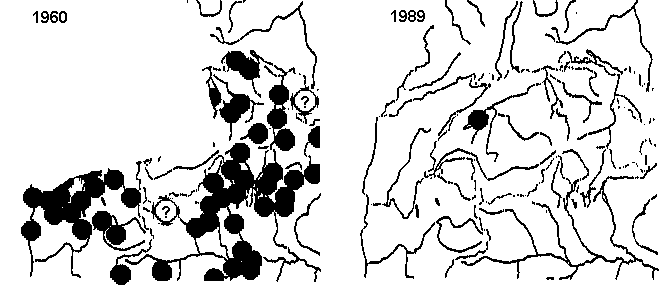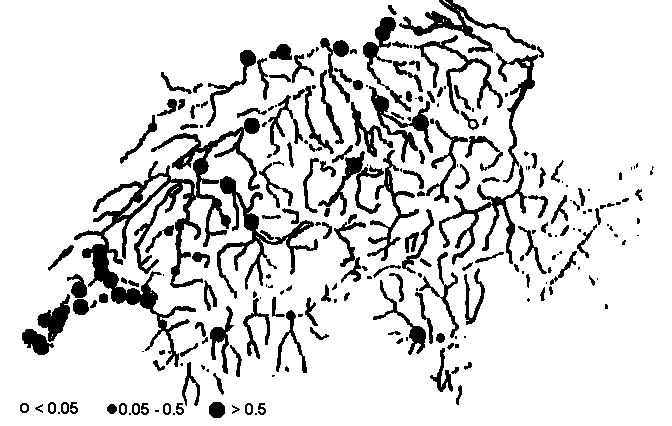|
Volume 5 Pages 1 - 83 (March 1990)
Citation: Weber, D. (1990) The End of the Otter and of
Otter Reintroduction Plans in Switzerland. IUCN Otter Spec. Group Bull. 5:
45 - 50
Previous | Contents |
Next
The End of the Otter and of Otter Reintroduction
Plans in Switzerland
Darius Weber
Hintermann & Weber AG, eco-logical
consultants, Hauptstrasse 44, CH-4153 REINACH, Switzerland
|
Abstract: Otters are now extinct in Switzerland.
Switzerland has to be considered as a country where viable otter
populations cannot exist now and in the foreseeable future, because PCB
levels in fish are much too high and not decreasing. Reintroduction
programs cannot be justified. The message to the public is that sometimes
nature cannot be repaired, pollution is out of control and we must learn
from the lesson of PCB-caused otter extinction.
|
THE OTTER GROUP SWITZERLAND, ITS PLANS AND THE QUESTIONS TO ANSWER
In 1984, the Otter Group Switzerland started its work. Members of the group
were both governmental (Wildlife service. Nature conservation, Fisheries,
Veterinary service) and non-governmental (WWF Switzerland, Nature Conservation
Organisation, otter-studbook keeper). Founding for projects was provided by the
federal agencies concerned.
It was the goal of this group to re-establish a viable otter population in
Switzerland by means of habitat protection, habitat improvement and eventually
reintroductions. From the beginning it was clear that the recommendations of the
IUCN otter specialist group would be followed.
In 1984, the available information on otters in Switzerland suggested, that
the reintroduction of the seventies had been successful and that there were some
additional otters surviving in the western part of our country and probably also
in southern parts (in contact with Italian otter populations).
The main questions to be answered before planning actions were:
- Where do otters still live in Switzerland and what is the status of
eventually existent otter populations?
- Habitat:
- Does habitat quality in Switzerland match the needs of a viable otter
population (of at least 50 individuals)?
- If not, what must be done to improve habitats, and where are the key
regions to do it?
- Do the factors responsible for the otter decline still operate?
- Are otters for eventual reintroductions available?
Within the last six years, the otter group tried to answer these questions an
seriously as possible, based on a series of specific baseline studies. Some of
these studies will be published. Unpublished reports are available from the
author of this paper.
THE ANSWERS
- Status of the Otter in Switzerland
There is only one place in Switzerland with freeliving otters (probably only
one individual left in 1989); the decline has continued during the seventies
and eighties even in the best protected otter habitats of Switzerland. The
reintroduction of 1975 was unsuccessful, although reproduction has occurred
at least once (1982) . Due to an insufficient scientific program, we know
hardly anything about the reasons of this failure.

|
| Figure 1: Presence of
Otters in and around Switzerland 1960 and 1989 |
- Habitat Quality
Habitat quality was evaluated applying a habitat suitability model
especially developed on the basis of the relevant scientific information
available in 1987. The main factors incorporated in this model are fish-biomass-density,
cover, absence of. nocturnal human activities, presence of undisturbed
areas. It was concluded that there are several regions in Switzerland, which
still match the needs of an otter population. In habitats classified as
insufficient, most often fish biomass was considered the crucial factor.

|
| Figure 2: PCB-Levels in
Fish from different Sites in Switzerland: whole fish, ppm fresh
weight, mainly trout, no eels) |
- Factors Responsible for the Otter Decline
It is not possible to exactly state to which extent different factors have
contributed to the otter decline in Switzerland. However, it is puzzling
that otters have disappeared in "untouched" river systems in
Switzerland as well as in the neighbouring parts of France and Italy, where
they had survived until the seventies (and locally until the mid-eighties).
The only hypothesis explaining sufficiently this phenomenon is contamination
of fish with organochlorine substances, especially PCBs (a review of the
available data showed that levels of heavy metals and organochlorine
pesticides are relatively low in fish in Switzerland). The otter group
therefore initiated a study on PCB-contamination of fish in those
watercourses which are considered providing the best otter habitats in
Switzerland. Together with other data on PCBs in fish, the results of this
study are appalling: PCB-levels range from 0.04 to 8.4 mg/kg (some ten whole
trouts per site homogenated, fresh weight). For comparison: Minimum
concentrations affecting otter populations are estimated 0.02 - 0.05 ppm
(Sim Broekhuizen and Mats Olsson, pers. comm.). The PCB contamination in
Switzerland is considered stable; there is no sign of a decrease.
- Otters for eventual Reintroducing:
Captive breeding success in several zoos of Switzerland would allow
reintroduction projects without otters caught in the wild.
CONCLUSIONS
The otter group concludes, that
- Instead of considerable efforts to save the otter, the species is now
extinct in Switzerland.
- Based on the current knowledge, Switzerland has to be considered as a
country where viable otter populations cannot exist now and in the
foreseeable future, because PCB levels in fish are much too high and not
decreasing. This conclusion is independent of the fact, that we do not
exactly know whether and to which extent other factors have also contributed
to the decline of the otter in Switzerland.
- Reintroduction programs cannot be justified as long as the PCB
concentrations in fish is not drastically reduced or future research has not
led to a rejection of the PCB-otter hypothesis.
INFORMATION OF THE PUBLIC
The otter group has decided to use its energies to inform the public on its
conclusions, trying to spread the following general rules and messages:
- Sometimes, nature cannot be repaired, even when money and manpower
are available. Therefore try to conserve nature as long as there is
something left to save.
- Things are out of control. There is not even an idea of how we
could eliminate the PCBs from the biota affected. Nobody has yet formulated
a convincing concept about how we could prevent the large quantities of
diffusely spread PCBs in the technosphere to enter the food-chains.
- Learn from the PCB-lesson: Do no longer allow industrial production
of a chemical before there are methods available to detect it in the
biosphere (even in very low concentration). Do immediately stop the
production of any chemical suspected to be dangerous (not only some
applications) . Do not buy and use products containing halogenated
hydrocarbons.
PUBLICATIONS IN PREPARATION
Nicollerat, M.S., Rossel, D., and Tarradellas, J. (1989): Results of
the analyses of PCBs and DDT in fish from lakes and rivers of Switzerland
Weber,D., Weber; J.-M. and Müller, H. -U. Otters in the
Schwarzwasser-Sense-catchment: documentation of an unsuccessful re-introduction
project, (Gerrnan; French and English summary)
Weber, J.-M., Weber, D. (1989) The otter (Lutra lutra L,) in
Western Switzerland.
Weber, D. The extirpation of otters in Switzerland: a history of the
changing problems in conservation, (in German)
UNPUBLISHED REPORTS AVAILABLE
All mandated and financed by the Federal Office of Environment, Forests and
Landscape, Berno)
Weber, D. (1987) A model to evaluate potential otter habitats in
Switzerland. (50p; German and French version available)
Weber, D., Weidkuhn, C. and Hohl, C. (1988) Western Switzerland and
Ticino as potential otter habitats. (64pp; German and French version available)
Weber, D. and Weber, J.-M. (1989) The otter in western Switzerland
(14pp; in German and French)
Weber, D. (1990) PCBs as the cause of the otter decline in Europe and
in Switzerland: hypothesis, facts, missing evidence. (17pp; in German)
Weber, D. (1990) The extirpation of the otter in Switzerland.
(15pp; in German and French)
Previous | Contents |
Next
|


